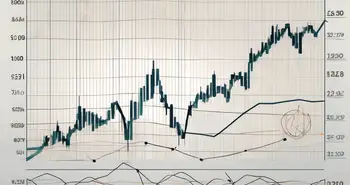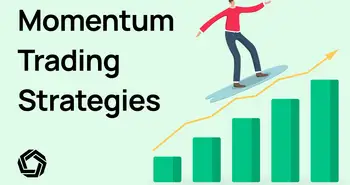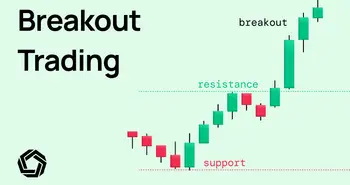Momentum Trading 101: Everything You Need to Start
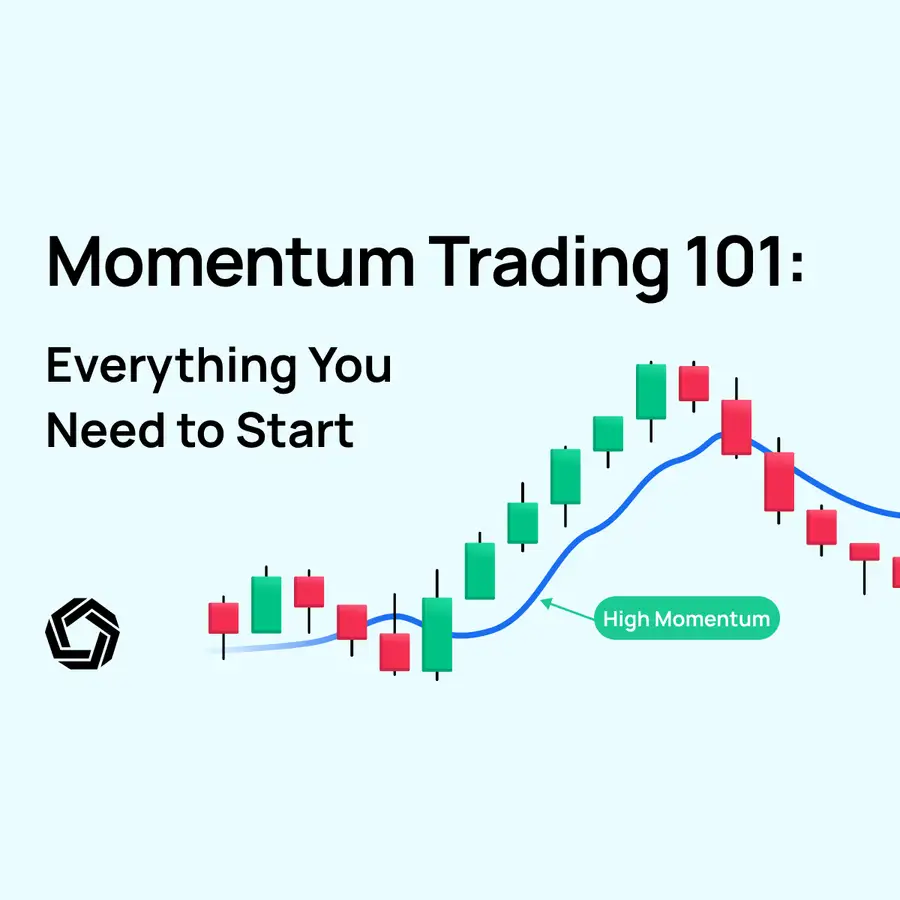
Momentum trading is a bit like surfing: traders look for stocks that are already on the rise and jump on, hoping to ride the wave to the top. This strategy is about spotting winners early—think of choosing the top golfers out of a list, expecting them to keep winning.
In this article, we're going to learn from the pros like Richard Driehaus and William O'Neil, who have made a name for themselves by knowing which stocks are likely to keep going up. It's not just about the excitement of the chase; it's about smart moves and timing your actions right. So let's dive into the world of momentum trading and see how the experts catch the big waves in the stock market.
Fundamental Concepts of Momentum Trading
Momentum trading is the art and science of buying securities that are on an upward trajectory and selling them as they reach their peak.
Here is a simple explanation of the concept of momentum, aka. Relative Strength, by Tom Dorsey:
If I gave you a list of the 100 best golfers worldwide and asked you to pick who you thought would be in the top 10 at the end of the next quarter, who would you pick? My guess is you would pick the current top ten to be in the top three months from now. Even if I asked you to pick the ones who would be in the top ten after one year, you would probably pick the current top ten.
At the end of the contest, some would have fallen out, and some would have moved up, but the majority would still be in the top ten. This is outperformance. It relates to Newton’s Law of motion, which suggests that objects that are in motion tend to stay in motion until an external force acts upon them. We believe that stocks that have good fundamentals, in a market that in general is supporting higher prices, and the chart pattern clearly shows that demand is in control of the stock, tend to continue to do well. Golfers who have good fundamentals, are in good shape, and at the top of their game, tend to continue to do well.
Buy the winners.
How Professionals Excel in Momentum Trading
In the investment world, momentum trading stands out for its simplicity and, paradoxically, its nuance. Hence, unlike other blogs that just describe the basic concept of momentum trading, we want to show you how actual professional traders used this concept. In a book about Charlie Munger, “Damn Right!” by Janet Lowe, Charlie talks about his view on teaching finance. He says that he would use the histories of a hundred or so companies that did something right or wrong as a basis for teaching the course. So, we will do the same in this blog.
For our analysis, we will use pros that actually applied momentum strategies, traders like Richard Driehaus and William O'Neil.
Richard Driehaus: Buying High and Selling Higher
Driehaus's investment philosophy might raise eyebrows among value investors, but it's a cornerstone of momentum trading. The idea is simple: identify stocks already on an upswing and catch the ride. It's akin to spotting a winning horse mid-race and betting on it to keep its lead. This counterintuitive strategy eschews the traditional hunt for undervalued stocks and focuses instead on those flexing their muscles in real-time.
Richard Driehaus, the acclaimed father of momentum investing, founded Driehaus Capital Management in 1982, a firm which has grown substantially to manage over $13.2 billion. His investment approach garnered impressive results, with the firm producing a compounded annual return in excess of 30% over 12 years. This extraordinary performance earned him a spot on Barron’s “all-century” team, highlighting him as one of the 25 most influential figures in the mutual fund industry.
Driehaus's investment philosophy hinges on the belief that a firm’s earnings growth is the primary driver of its stock price. He emphasized that “Companies that have a record of strong and consistent earnings growth have been the most successful ones.” This perspective underpinned his preference for picking small-cap stocks that presented the greatest earnings growth potential, diverging from the traditional value investing approach that focuses on undervalued stocks with low P/E ratios. Driehaus argued that value investing often overlooked the best performers due to their above-average P/E ratios.
Driehaus's strategies were characterized by his unique approach to stock selection. He sought companies with a strong market position and improving outlooks, particularly in sectors that were beneficiaries of secular changes. Contrary to the traditional long-term holding strategy, he believed in closely monitoring stocks and being ready to act on short-term information. He contended that stock prices were heavily influenced by market dynamics and investors' emotions, which could swing from pessimism to optimism.
Driehaus challenged several investment paradigms:
- Buy Low and Sell High: Driehaus's approach was to buy high and sell even higher, focusing on stocks that were already in demand and showing positive relative strength.
- Long-Term Holding of Good Companies: He believed that holding stocks should be conditional on continued favorable performance and that investors should remain vigilant, ready to respond to any unfavorable changes.
- Avoidance of High Turnover Strategies: Driehaus advocated for a high turnover approach when necessary, taking small losses to avoid larger ones and not holding onto stocks with deteriorating fundamentals.
- Systematic Investment Processes: He felt that investment processes should be disciplined yet flexible enough to respond to changing market conditions, rather than rigidly systematic.
- Valuation as the Key Factor: Driehaus believed that in the short run, valuation was not the primary determinant of stock price.
- Necessity of Standard Research and Analyst Contact: He valued news reports, company contacts, and technical information as the best sources of research, as they directly affected company fortunes.
- Standard Deviation as a Measure of Risk: Driehaus viewed volatility as a risk only for short-term assets, suggesting that the real risk for many investors was insufficient exposure to high-returning, more volatile assets.
- Relying on ‘Star System' Managers: Contrary to the belief that it's risky to place money with star system managers, Driehaus argued that top performance is often achieved by the stars in any industry.
Richard Driehaus's insights reveal that, sometimes, defying conventional wisdom can unveil significant investment opportunities. He stressed the importance of utilizing both analytical and creative thinking in investment decision-making, always maintaining a sense of awe and adaptability to the ever-changing, illogical nature of the stock market. His legacy in momentum investing continues to influence and inform investment strategies today.
William O'Neil's: CAN SLIM
The investing world recently bid farewell to a legendary figure, William J. O’Neil, who passed away on May 28, 2023, at the age of 90. O'Neil, renowned for founding Investor’s Business Daily and authoring “How to Make Money in Stocks,” left behind a legacy through his CAN SLIM strategy—a mnemonic for seven crucial factors characteristic of winning stocks.
CAN SLIM is a distinctive strategy aimed at identifying stocks with robust historical and projected growth, poised for rapid price increases. It encompasses market-timing to ensure investments are made during market uptrends, thereby aligning with the flow rather than against it. The efficacy of the approach is evident in the performance of AAII’s O’Neil CAN SLIM No Float screening model, which since its inception in 1997, has garnered an annual gain of 12.2%, significantly outstripping the S&P 500 index's 5.7% over the same period.
O'Neil's investment outlook was deeply rooted in the belief of America's sustained economic growth, driven by freedoms and opportunities that have positioned the U.S. as a beacon of entrepreneurial success. His aim was to identify shares of smaller, innovative firms—often the birthplace of groundbreaking products and services—with the potential for substantial price growth.
He constructed his strategy based on a rigorous analysis of 40 years of market data, identifying the common threads among the highest-performing stocks each year. His findings distilled into the CAN SLIM methodology, emphasizing a blend of fundamental factors intrinsic to the companies and technical factors derived from stock price patterns.
The components of CAN SLIM are simple, each letter in the acronym represents a key trait to look for in potential investments:
- C for Current Quarterly Earnings Per Share: O’Neil looked for stocks with a minimum of 18% to 20% increase in quarterly earnings per share over the same period from the previous year, emphasizing the significance of earnings acceleration.
- A for Annual Earnings Increases: A steady and significant record of annual earnings growth was another hallmark of successful stocks, according to O'Neil’s research. Earnings over the last 12 months be greater than or equal to earnings from the latest fiscal year.
- N for New Products, Management, or Highs: This aspect underscored the importance of a catalyst, such as a new product or management, to propel a company’s stock forward. 95% of the winning stocks had some sort of fundamental spark to push the company ahead of the pack.
- S for Supply and Demand: Winning stocks often had fewer shares outstanding, making them more susceptible to price movements on increasing demand. O’Neil found that 95% of the winning stocks had fewer than 25 million shares outstanding, while the median for the group was 4.6 million shares.
- L for Leader or Laggard: O’Neil favored buying stocks that were market leaders within their industries, using relative strength as a metric to identify them. O’Neil suggests only considering stocks that have relative strength rankings of 80% or 90% with a chart base pattern. For example, you can use something like a Stock Sector Heatmap to get a quick assessment of the potential leaders.
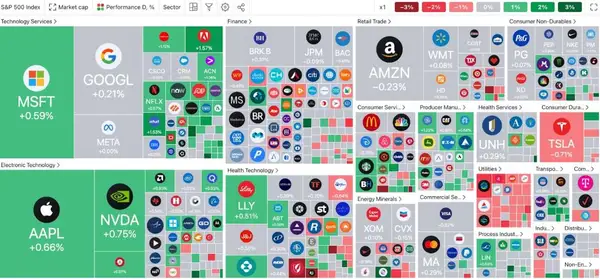
- I for Institutional Sponsorship: A moderate level of institutional ownership was necessary for a stock to perform well, according to O’Neil.
- M for Market Direction: Recognizing the market trend was critical, with O’Neil advising to invest during bull markets and retain cash during market downturns. O’Neil recommends that you try to put 25% of your portfolio into cash.
Key Technical Indicators for Momentum
Now besides these clear strategies that relied more on fundamental analysis with financial data like Earnings, what if you wanted to trade momentum with a more technical approach using indicators?
Here is a list to get you started with the main indicators you can use for momentum trading, which even give you different time frames to trade in.
Relative Strength Index (RSI):
- Ranges from 0 to 100, with thresholds typically set at 70 (overbought) and 30 (oversold).
- Guidance from Linda Bradford Raschke: “Consider a two-period RSI to identify extreme conditions for a probable reversion to the mean.”
Stochastic Oscillator:
- Also ranges from 0 to 100, with over 80 considered overbought and under 20 considered oversold.
- Guidance from George Lane: “Employ the %K and %D lines in the stochastic oscillator to identify potential price turnarounds.”
Moving Average (MA):
- Common periods for MAs are 20, 50, and 200 days, signaling short-, medium-, and long-term trends.
- Guidance from Jesse Livermore: “The real money in trading is made in the big swings. Watch the 200-day MA for these moves.”
Moving Average Convergence/Divergence (MACD):
- The MACD line is the difference between the 12-day and 26-day exponential moving averages (EMAs), while the signal line is the 9-day EMA of the MACD line.
- Guidance from Gerald Appel: “Pay attention to the MACD signal line crossovers to identify momentum shifts.”
Crossover Strategies
- Bullish Crossover: Occurs when a shorter-term MA (like the 20-day) crosses above a longer-term MA (such as the 50-day or 200-day).
- Bearish Crossover: Happens when a shorter-term MA crosses below a longer-term MA.
- Guidance from Richard Driehaus: “Momentum investing is about buying strength and selling weakness. A crossover of the 50-day above the 200-day MA can be a strong buy signal.”
By integrating these indicators into your trading strategy, you can effectively capture market momentum. Remember the advice of Paul Tudor Jones: “Don’t ever average losers.” This means that while indicators can guide entry points, they should be complemented with strict risk management rules such as stop-loss orders to protect against the downside.
Risk Management in Momentum Trading
Momentum trading thrives on capturing swift market movements, but without solid risk management, it's akin to sailing in stormy seas without a compass. Here's how seasoned momentum traders navigate these waters:
Selecting the Right Assets
- Liquidity is Key: High liquidity means easier entry and exit at expected prices. This is critical in momentum trading where timing is everything. Ultimately, while many factors can impact momentum trading strategies, it’s important to remember that the market is ultimately a game of liquidity.
“It’s the liquidity, stupid! S&P 500 trades in tandem w/liquidity of global central banks. Liquidity matters, always!” – Holger Zschaepitz
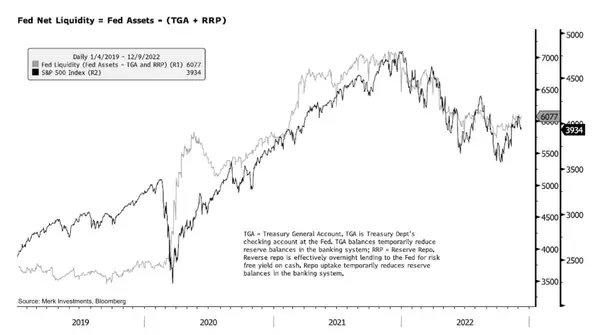
- Steer Clear of Leverage as the only indicator: Leveraged assets can amplify movements, but they may not truly reflect the underlying asset's momentum.
- Keep an Eye on the News: Sudden surges often follow newsworthy events. Whether it's a tech breakthrough or a merger, staying abreast with reliable news sources can offer a strategic edge.
Position Management Strategies
- Duration Dictates Position Size: The length of your intended hold should directly influence how much you're willing to commit. Short-term traders might opt for larger positions due to the brief exposure, while long-term traders often go smaller to mitigate extended risk.
- Day Trading with Momentum: In the realm of day trading, positions are typically larger to capitalize on short-term market movements.
- Multi-Day Position Sizing: For those who play the longer game, scaling down position sizes helps manage the increased risk that comes with time.
Adopting these principles isn't just about preserving capital; it's about cultivating discipline. Consider the words of Paul Tudor Jones, “The most important rule of trading is to play great defense, not great offense.” By focusing on risk management, momentum traders set themselves up not just to survive but to thrive in the market's ebbs and flows.
A Stock Momentum Trading Strategy
Talking about momentum, we created a simple strategy for you to try. With this strategy, you can directly hop into the charts and try to use momentum to your advantage, regardless of the market going up or down. In this case, we are actually showing you a momentum strategy that will profit from an asset losing its momentum and going into downward momentum, resulting in a beautiful swing trade.
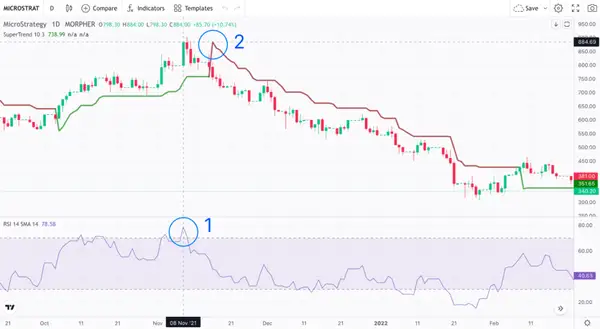
This trading strategy integrates the Relative Strength Index (RSI) and SuperTrend indicators to pinpoint potential momentum shifts in asset prices. We'll demonstrate using MicroStrategy (MSTR) stock as an example, but the approach is applicable to any asset.
The RSI gauges an asset's price momentum, highlighting overbought conditions with readings above 70 and oversold states when below 30. On the other hand, the SuperTrend indicator provides buy or sell signals depending on the asset's price in relation to a calculated band, which incorporates the average true range and a moving average. This indicator is represented as a thick line on the chart, shifting from brown to green across the candlesticks to indicate trading directions: green below the closing price suggests a buy signal.
Observing the MSTR chart, we noticed an uptrend peaking on November 8, 2021, which reversed the next day. The RSI reading was around 75, marked as “1” on the chart, hinting at an overbought status and a possible trend reversal. Similarly, the SuperTrend indicator, marked as “2,” switched from green to brown, corroborating the reversal signal.
Acting on these cues, a promising entry for a short position could be at approximately the 700 level, maintaining the position down to the 400 level. This is where the RSI indicated oversold conditions with a reading below 30. Alternatively, waiting for the SuperTrend to flip back to green could offer further confirmation for a trend reversal.
It's important to note that MicroStrategy's stock is closely tied to Bitcoin movements because of its substantial Bitcoin holdings. Thus, significant shifts in the cryptocurrency market can influence MSTR's performance. Nonetheless, the RSI and SuperTrend indicators equip us to make informed trading decisions based on the prevailing market scenarios and price dynamics.
A Sector Momentum Trading Strategy
The Beta Rotation Strategy (BRS) is a momentum-based trading method that outperforms traditional buy-and-hold strategies by strategically rotating investments between the Utilities sector and the broader market. This strategy was proposed by Michael Gayed and exploits the lead-lag relationship of the Utilities sector, which is not immediately priced into the market, providing an avenue for outperformance, particularly during economic downturns or bear markets.
Trading Rules:
- Monitor the 4-week rolling relative strength of the Utilities sector against the broader market.
- Rotate into Utilities when the sector shows positive relative strength over the past 4 weeks, signaling lower beta is favorable.
- Rotate into the broader market when the Utilities sector shows negative relative strength, indicating a preference for higher beta.
- The strategy benefits from the higher dividend yields in the Utilities sector through compounding.
- Utilize a long/short approach as an alternative: go long on Utilities and short the market when rotating into Utilities, and the reverse when rotating into the market.
The BRS demonstrates consistent outperformance across various market cycles and offers superior risk-adjusted returns. It's particularly effective during market upheavals and shows persistent strength over rolling 3-year periods. The strategy also capitalizes on seasonal patterns, such as “sell in May and go away,” with Utilities often acting as a predictive signal for increased market volatility.
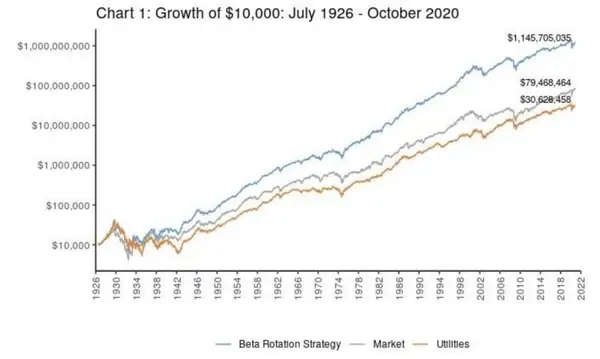
In essence, the BRS is an adaptable strategy that leverages sector momentum and relative strength for strategic asset allocation, aiming to maximize returns while managing market risk.
Pitfalls & Critics of Momentum
One prominent figure in the world of investing who has shared his skepticism about momentum trading is Benjamin Graham, often known as the father of value investing. Graham is quoted as saying, “In the short run, the market is a voting machine but in the long run, it is a weighing machine.” This analogy criticizes the idea of momentum trading by suggesting that while market sentiment (votes) can drive prices in the short term, the true value (weight) of companies is what determines stock prices over the long term.
Graham’s philosophy is built on the foundation of investing with a margin of safety, which is in stark contrast to the high-risk nature of momentum trading. He advises investors to look for undervalued opportunities where the price does not reflect the intrinsic value, and to invest with a long-term horizon.
The pitfalls of momentum trading can, therefore, be tied back to Graham's core principles of investing: that a strategy based on the whims of market sentiment is inherently risky and can lead to unstable results. The discipline in momentum trading comes not just from identifying trends but also from understanding the fundamental value of investments to ensure one is not caught in the precarious position of holding overvalued assets when the market sentiment shifts. The wisdom here is to know the value of what you’re trading, not just its price trend.
Parting Wisdom
“Markets are never wrong – opinions often are. The big money is not in the individual fluctuations but in the main movements – that is, not in reading the tape but in sizing up the entire market and its trend.”
Jesse Livermore
To thrive in momentum trading, one must develop an eye for market trends, a disciplined mindset, and an unwavering commitment to risk management. It's not just about the numbers; it's also about the stories that drive those numbers. Remember, momentum trading isn't just about catching the big waves—it's about knowing when to paddle out to ride them and when to head back to the safety of the shore.

Disclaimer: All investments involve risk, and the past performance of a security, industry, sector, market, financial product, trading strategy, or individual’s trading does not guarantee future results or returns. Investors are fully responsible for any investment decisions they make. Such decisions should be based solely on an evaluation of their financial circumstances, investment objectives, risk tolerance, and liquidity needs. This post does not constitute investment advice.

Painless trading for everyone
Hundreds of markets all in one place - Apple, Bitcoin, Gold, Watches, NFTs, Sneakers and so much more.

Painless trading for everyone
Hundreds of markets all in one place - Apple, Bitcoin, Gold, Watches, NFTs, Sneakers and so much more.

